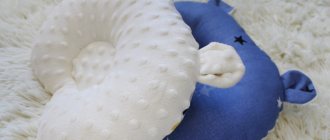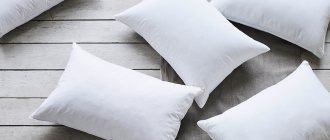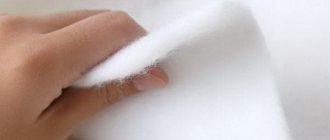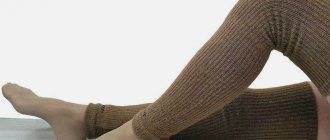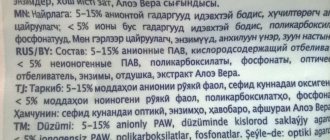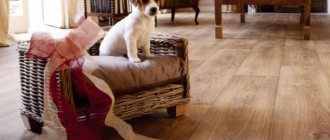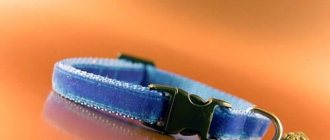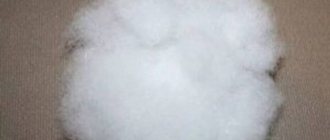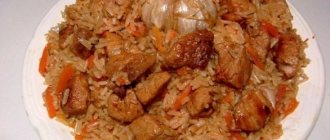The success of a good, complete rest largely depends on the correct choice of bedding - pillows and blankets. Soft, warm, cozy, they provide complete relaxation and create comfortable conditions for quality sleep. Filling is an important component of blankets and pillows. His choice determines how pleasant and sound the sleep will be, and whether it will bring restoration of strength and energy. Among the latest proposals from filling manufacturers, synthetic fluff deserves special attention.
What is synthetic fluff?
Sintepuh what is it? It is also called synthetic down - a soft, fluffy non-woven material used as a filler for pillows and blankets, and also used in other industries. The raw material for it is hollow polyester fibers, twisted into spirals and interconnected. To give the material elasticity, it is treated with silicone.
Important! Synthetic fluff was developed using the latest technologies and combines the best qualities of synthetic fillers. Textile manufacturers have recognized this material as an excellent substitute for waterfowl down and one of the most popular in the production of bedding.
Properties and Features
Thanks to modern technologies, synthetic down has acquired properties that have made it a popular filler:
- softness,
- ease,
- volume,
- elasticity,
- breathability,
- non-hygroscopic;
- thermal insulation;
- hypoallergenic;
- antibacterial.
Many synthetic materials have similar properties. Sintepuh has a unique feature. The material is produced using combing technology, due to which it has the ability to retain its elastic and airy shape for as long as possible. Even after dozens of washes, it does not fall into lumps and quickly restores its shape after prolonged deformation.
About the material
Eco-friendly and efficient building insulation materials and Hollofiber materials have been in increased demand in recent years. Hollofiber structure - polyester insulation for thermal insulation of any structures of country houses, apartments, industrial facilities, etc. The material does not contain binding components, is absolutely inert and environmentally safe for human health. Polyester insulation is one of the warmest among existing building insulation materials (λ = 0.03 W/m*K). An excellent solution for “green” and energy-efficient homes, both permanent and periodic residences.
Characteristics of synthetic fluff
Synthetic down is a light fluffy material, the fibers of which are specially treated with silicone before twisting. They acquire a perfectly smooth surface, which allows the filler to spring back easily. The silicone coating is quite durable. It can withstand dozens of washes. As a result, synthetic fluff retains its quality characteristics for a long time.
The filler undergoes antibacterial treatment before use, which prevents the formation of fungus. Antistatic impregnation prevents the accumulation of static electricity. Dust does not accumulate in synthetic down, which is an ideal breeding ground for dust mites.
This method of preparing the filler increases its hypoallergenic qualities.
Important! Synthetic fluff is recommended for use in children's pillows and blankets. It is used as insulation for children's winter clothing and for stuffing soft toys.
Where is it used?
The scope of application of synthetic down is textile and furniture production. In the latter, it is rarely used, since the cost of the material is quite high. Manufacturers prefer to lay cheaper fillers as a layer between the form-building material and the upholstery.
Most often, synthetic down is used for stuffing pillows and blankets. It is widely used when sewing winter outerwear, including those intended for active winter recreation. Less often it can be found in children's soft toys.
Blankets and pillows made from synthetic feathers are soft, light, and thermally insulating. They are well ventilated, quickly regain their shape, are easy to wash and dry quickly.
The video demonstrates an overview of a pillow filled with synthetic (swan) down
Filler
A natural or synthetic fiber that supports your head and neck in a natural position.
Synthetic
Natural
Hypoallergenic
Durable
Washable
Environmentally friendly production
Filler
Description
Siliconized fiber is made from polyester fibers impregnated with silicone to maintain shape and elasticity. It feels like down: just as airy and silky. Pillows with this filling can be machine washed and do not lose their shape over time. An excellent replacement for a down pillow for people prone to allergies.
Name options: “Swan down”, artificial down feather, polyester fiber, highly siliconized fiber, 4-L fiber, royalon, microfiber, microgel, highly crimped siliconized fiber, nanometer.
Holfitex is a polyester fiber that is not impregnated with silicone. Combines softness and elasticity, perfectly restores shape. Holfitex pillows can be machine washed, but they do not last long, no more than two to three years.
Variant names: holfit-balls, holfit-plast, holfitek, holfit.
Feather and down pillows are classics. Sleeping on them is soft and warm. The ratio of down and feathers in the filler varies: the more down, the softer the pillow and the higher its cost.
Based on the ratio of feather and down, pillows are divided into several classes:
Filler class
Amount of fluff
Pen quantity
Down Extra
| 50×70 cm | ||
| Goose down at least 90% | Fine goose feather no more than 10% | |
Downy category I | Goose down 90% – 65% | Small goose feather 10% – 35% |
Semi-down category I | Goose down 70% – 15% | Fine and medium goose feather no more than 30% – 85% |
Semi-down category II | Duck down 50% – 15% | Small and medium duck feather 50% – 85% |
| We do not recommend using down or feather pillows for people prone to allergies. Bamboo and eucalyptus fiber are viscose fillers that have an antibacterial effect. They absorb moisture very well, so the pillow remains dry, even if it’s hot at home. Natural cellulose materials do not cause allergies. Silk is a very rare and expensive filler. Most often, several types of silk or a combination of silk with siliconized fiber are used in the pillow. Natural silk is an environmentally friendly and hypoallergenic material. Pillows with silk filling will last you a very long time. Animal wool and down are more often found as filler in pillow covers in combination with siliconized fiber. Wool has a warming effect and helps with muscle and joint pain. Animal wax lanolin, which is found in all types of wool, softens the skin and has antibacterial properties, but it is also often the cause of allergic reactions. Types of wool and down fillings: FillerDescriptionGoat and sheep woolThe simplest and most affordable wool fillings gently warm and have a healing effect. Camel wool and downMaintains a constant temperature, absorbing and evaporating moisture better than any other wool, and contains the largest amount of lanolin. CashmereThin and very warm fluff of Kashmir goats, which live in the harsh climate of the Himalayas. Merino woolThis is a thin and very voluminous wool of one of the types of sheep, it retains moisture better than ordinary sheep's wool and gives soft, dry warmth. | |
Alpaca woolThe soft and light fur of a small animal similar to a llama. Alpaca wool is practically waterproof and does not contain lanolin, which means it is hypoallergenic. In production, all types of wool are washed and delicately processed, so it is not prickly and has no odor. PositionHardness levelFillers | |
| Elastic |
|
| Average |
|
| Soft |
|
Natural plant fibers
Algae, buckwheat husks, and medicinal herbs have unique medicinal properties, and some of them also smell pleasant.
Wool and down of camel, goat, sheep
Warms, relieves headaches and arthritis. During production, the wool is processed, so it does not prick and has no odor.
They can be the main filler or sewn into the cover, the cost of the pillow depends on this. Hypoallergenic, have antiseptic properties.
Good for the skin, has a lifting effect, the most durable, but also the most expensive filler.
| Note! Some pillows have a hidden zipper sewn into them. It is needed not only to ensure the quality of the product. Through the hole you can remove excess filler, the pillow will become lower and softer. Some pillows have a double cover with filling, which can perform various functions from adding fluffiness to improving health. ExampleFillerDescription |
| In its pure form, it is not used as the main filling of a pillow, because it does not hold its shape well. The down filling in the cover makes the pillow soft and fluffy like a cloud. |
Advantages and disadvantages of synthetic fluff
Synthetic fluff is a synthetic filler that is produced using modern technologies. The material, compared to traditional natural fillers (down or feather), has a number of advantages.
- Does not cause allergic reactions. After antibacterial treatment, harmful microorganisms and mites that provoke allergies will not grow in the synthetic fluff.
- Retains elasticity for a long time. Treating fibers with silicone improves their spring properties.
- Does not absorb moisture. The synthetic down filler is non-hygroscopic, which helps it dry quickly after washing.
- Lightness and softness. Hollow fibers are lightweight and have high volume.
- Low price compared to natural materials. The filling made from polyester fibers is inexpensive.
Synthetic fluff has virtually no disadvantages. Only in comparison with other artificial fillers is it more expensive, since new innovative technologies are used in its production that increase its quality and cost.
Better without impurities
In addition to the beautiful design of a down jacket, it is also important to know whether it will keep you warm during a business trip to Yakutia and whether all the down will end up in the sleeve after washing. The most durable and warmest down jacket is considered to be made from goose, swan and eider down.
The label should say down. Feather is often added to fluff. The service life of the jacket is from 5 to 20 years. Duck down is the most short-lived: after 6-7 years it loses its properties. A less warm alternative to a down jacket is a jacket with a wool lining that says wool on the label.
You should not buy jackets with synthetic padding: after the first wash, it clumps into small clumps and the jacket becomes unusable.
Not so long ago they came up with a new material - synthetic fluff. It has the properties of down, does not cause allergic reactions and is cheaper.
What is better synthetic fluff or holofiber?
Synthetic fluff and holofiber are synthetic fillers with similar characteristics. They differ in the form that polyester fibers take after manufacturing: synthetic fluff is twisted into springs, and holofiber is twisted into balls.
Holofiber is manufactured using different technologies. Thermally produced material is inferior to synthetic fluff in terms of caring for products with this filler. Hollow fiber cannot be washed at high temperatures, since the adhesive composition dissolves and the connection between the fibers is lost. As a result, the product ceases to be elastic and loses softness.
You may be interested to know what holofiber is, its features, advantages and disadvantages.
There are no restrictions for synthetic fluff, but its cost is slightly higher than the price of holofiber.
Practical comparison
Despite the advantages of both materials, which largely coincide, the difference between the two insulation materials is very noticeable. If we take into account absolute indicators, then Thinsulate is superior to holofiber in many respects. It is more practical, warmer and more reliable, although it requires a more delicate attitude. The “capriciousness” of Thinsulate does not pose any problem, because there are special detergents and special machine wash modes.
However, Thinsulate is significantly superior to Holofiber in terms of price. If two similar products with different fillings are offered to you at the same price, then, most likely, instead of a high-quality filling, they are giving you a fake.
At the same time, holofiber in its price category is rightfully one of the best insulation materials. It is much easier to care for than Thinsulate. If we consider the conditions of standard household use, excluding extreme temperatures, then it is quite suitable for our winters. Thus, if the purchase budget allows, then the choice will clearly be in the direction of Thinsulate, and if you have to look for a compromise in the parameters of price and quality, then the choice will fall on holofiber.
Synthetic padding or synthetic padding: what's the difference?
Sintepokh was created on the basis of the previously invented synthetic winterizer. Modern technologies have made it possible to give the new filler better qualities.
Sintepuh has higher thermal insulation characteristics. For example, clothes with synthetic padding are designed for a maximum temperature of -15 °C, and with synthetic padding - -25 °C.
Synthetic fluff has greater elasticity and retains this quality longer. Blankets and pillows with this filling will last longer. They cost a little more, but benefit from their long service life.
You may be interested to know what padding polyester is, its features, advantages and disadvantages.
Recommendations for caring for products with synthetic down
Washing is not contraindicated for products with synthetic fluff. How to wash synthetic fluff? Clothes can be washed both manually and in automatic washing machines (in the delicate wash mode). For pillows and blankets, experts recommend choosing hand washing. Machine processing can speed up the wear process of products.
The temperature regime should be selected according to the quality characteristics of the fabric from which the pillow, blanket or jacket is made.
It is recommended to dry products with synthetic fluff in a suspended state under natural conditions. The hygroscopic material dries quickly, immediately after the water drains from it.
When choosing pillows and blankets with synthetic down, the buyer gives preference to high-quality modern filling, which will delight you with softness and elasticity for a long time, will warm you on a cool night, and will not cause allergies. Things with high-quality filling are more expensive, but they are much cheaper than products with natural materials.
LiveInternetLiveInternet
—Categories
—Search by diary
—Subscription by e-mail
— Regular readers
—Communities
-Statistics
Experiencing one of the most acute initial phases of the “disease” with a toy, I, like other “infected” people, frantically scour the Internet in search. patterns, answers to questions, ideas, etc. And so, when I got to the “Blog about the creativity of one naughty mother” https://www.olinohobby.com/, Olya’s creative mother, who also lives in my city, found an article that turned out to be very useful. I hope it is useful to you too
I FURTHER QUOTE THE AUTHOR:
But what happens when stuffing? It is quite difficult to distribute the cotton evenly inside the toy; it falls off and rolls, as if compacted in “layers”. If you unsuccessfully filled a toy (especially not a small one) with cotton wool, you will have to do it all over again. But when you take it out, you discover that it is impossible to restore it to its original fluffy form.
Wool gives a feeling of warmth, some kind of soulfulness or something. A toy stuffed with wool is very pleasant and soft to the touch.
1. SINTEPON.
Often sold in hardware stores. This is a non-woven fabric of various thicknesses, 1.5-2 m wide. Sold by the cut, like fabric.
Where can I buy? This is more difficult. Basically, manufacturers sell it in bulk (5 or 10 kg bag, or several such bags). But now there are more and more online stores that sell it by weight (price from 5 UAH per 100 grams). You can also look in markets where they sell pillows and blankets; sometimes you can buy 1 kg (from 35 UAH). You can buy together with other needlewomen. A 5 kg bag costs approximately 120-150 UAH. This will be enough for all of you and will still remain.
3. SYNTEPOUX BALLS.
Siliconized synthetic fluff balls are combed, highly crimped hollow siliconized polyester fiber, subsequently twisted into balls. Unlike padding polyester, the “balls” do not cake over time, so the finished product retains its original shape for a long time. Look in the same place as synthetic fluff. Prices are about the same. Many consider this the best filler for toys. But there are nuances. About them a little below.
Pros of synthetic fillers:
you can wash it and don’t worry that everything will turn into mush; it dries quickly; it does not cause allergies; it better retains the shape of the toy; it does not become food for small insects.
Thin foam rubber is suitable in torn form for stuffing knitted toys and those sewn from thick fabrics. Uniformity is difficult to achieve, but possible. Over time, the foam inside crumbles, crumbles and the toy loses its shape.
Source
